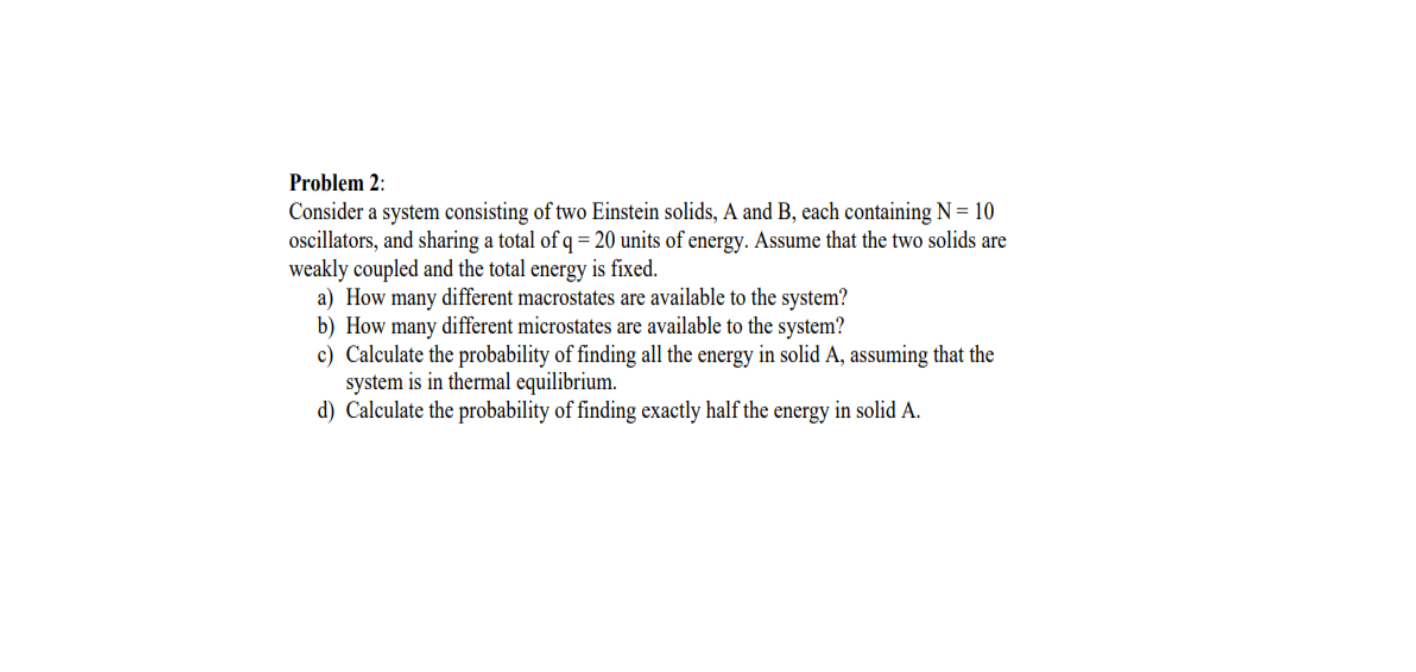Problem 2: Consider a system consisting of two Einstein solids, A and B, each containing N = 10 oscillators, and sharing a total of q = 20 units of energy. Assume that the two solids are weakly coupled and the total energy is fixed. a) How many different macrostates are available to the system? b) How many different microstates are available to the system? c) Calculate the probability of finding all the energy in solid A, assuming that the system is in thermal equilibrium. d) Calculate the probability of finding exactly half the energy in solid A.
Problem 2: Consider a system consisting of two Einstein solids, A and B, each containing N = 10 oscillators, and sharing a total of q = 20 units of energy. Assume that the two solids are weakly coupled and the total energy is fixed. a) How many different macrostates are available to the system? b) How many different microstates are available to the system? c) Calculate the probability of finding all the energy in solid A, assuming that the system is in thermal equilibrium. d) Calculate the probability of finding exactly half the energy in solid A.
College Physics
1st Edition
ISBN:9781938168000
Author:Paul Peter Urone, Roger Hinrichs
Publisher:Paul Peter Urone, Roger Hinrichs
Chapter31: Radioactivity And Nuclear Physics
Section: Chapter Questions
Problem 3PE: (a) Repeat Exercise 31.2, and convert the energy to joules or calories. (b) If all of this energy is...
Related questions
Question
100%
do part D please

Transcribed Image Text:Problem 2:
Consider a system consisting of two Einstein solids, A and B, each containing N = 10
oscillators, and sharing a total of q = 20 units of energy. Assume that the two solids are
weakly coupled and the total energy is fixed.
a) How many different macrostates are available to the system?
b) How many different microstates are available to the system?
c) Calculate the probability of finding all the energy in solid A, assuming that the
system is in thermal equilibrium.
d) Calculate the probability of finding exactly half the energy in solid A.
Expert Solution
This question has been solved!
Explore an expertly crafted, step-by-step solution for a thorough understanding of key concepts.
This is a popular solution!
Trending now
This is a popular solution!
Step by step
Solved in 4 steps with 3 images

Knowledge Booster
Learn more about
Need a deep-dive on the concept behind this application? Look no further. Learn more about this topic, physics and related others by exploring similar questions and additional content below.Recommended textbooks for you

College Physics
Physics
ISBN:
9781938168000
Author:
Paul Peter Urone, Roger Hinrichs
Publisher:
OpenStax College

Modern Physics
Physics
ISBN:
9781111794378
Author:
Raymond A. Serway, Clement J. Moses, Curt A. Moyer
Publisher:
Cengage Learning


College Physics
Physics
ISBN:
9781938168000
Author:
Paul Peter Urone, Roger Hinrichs
Publisher:
OpenStax College

Modern Physics
Physics
ISBN:
9781111794378
Author:
Raymond A. Serway, Clement J. Moses, Curt A. Moyer
Publisher:
Cengage Learning
